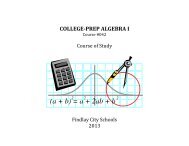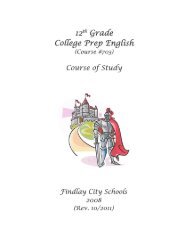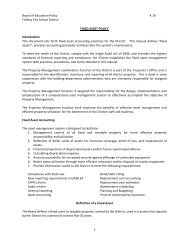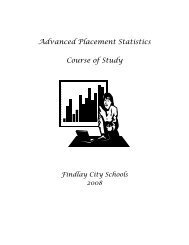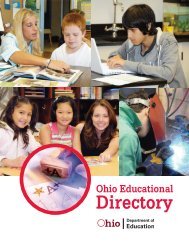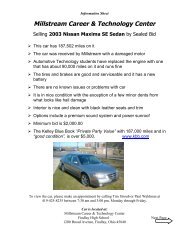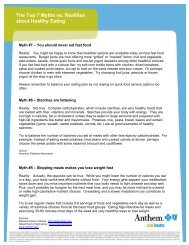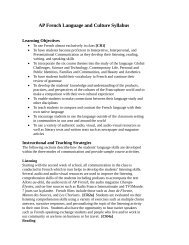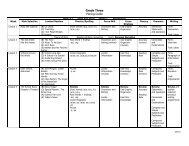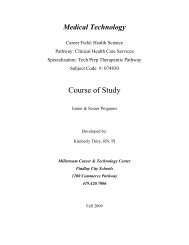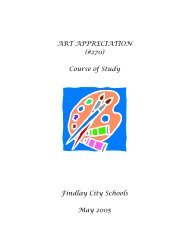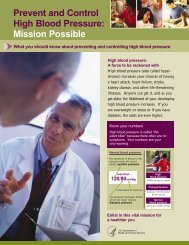6th GRADE SCIENCE - Findlay City Schools
6th GRADE SCIENCE - Findlay City Schools
6th GRADE SCIENCE - Findlay City Schools
Create successful ePaper yourself
Turn your PDF publications into a flip-book with our unique Google optimized e-Paper software.
8 th <strong>GRADE</strong>SPECIAL EDUCATION<strong>SCIENCE</strong>Course of Study<strong>Findlay</strong> <strong>City</strong> <strong>Schools</strong>2005
BENCHMARK D: Identify that the lithosphere contains rocks and mineralsand that minerals make up rocks. Describe how rocks and minerals areformed and/or classified.TOPIC/UNIT: 8 th : Earth/Earth SystemsTime Line: 2 weeksIndicator 1: Describe the rock cycle and explain that there aresedimentary, igneous and metamorphic rocks that have distinct properties(e.g., color, texture) and are formed in different ways.KNOW• How and where the different type ofrocks are formed.DO• Describe the rock cycle.
PRE-ASSESSMENT:• Develop a diagram that depicts the rockcycle.ASSESSMENT:• Rock classification• Chart• Two-Column Notes• Concept MapGRAPHIC ORGANIZER & OR TECHNOLOGY:• Ohio Natural History of Minerals. URL:http://www.ohiohistorycentral.org/ohc/nature/geology/minerals/index.shtmlView Full Record of ORC#: 2192. Thecharacteristics of 25 minerals that arefound in Ohio are detailed in thisresource.• Concept Map• Series of Events DiagramTESTING SKILL (S) & OR SAMPLEOGT TYPE QUESTIONS:• You are hiking and you pick upan interesting rock and seefossils of sea creatures in it.What type of rock would thisbe and why?BEST PRACTICES:• PreP• Cubing• Paired Reading Activity• Two-Column NotesRESOURCES:• Glencoe Science Earth Science• Reading and Writing Acrossthe Curriculum• A Handbook of ClassroomInstruction that WorksTESTING VOCABULARY:RockRock cycleHISTORICAL/MODERN LINK:
BENCHMARK D: Identify that the lithosphere contains rocks and mineralsand that minerals make up rocks. Describe how rocks and minerals areformed and/or classified.TOPIC/UNIT: 8 th : Earth/Earth SystemsTime Line: 2 weeksIndicator 2: Explain that rocks are made of one or more minerals. Identifyminerals by their characteristic properties.KNOW• The difference between a rock and amineral.• Examples of minerals.• The importance to your life style of gas,oil and propane.• The safe use of gas, oil and propane.DO• Describe the make up of a rock ormineral.• Be able to list some examples ofminerals.• List uses of gas, oil and propane.• Compare and contrast safe andunsafe uses of gas, oil and propane.
PRE-ASSESSMENT:ASSESSMENT:GRAPHIC ORGANIZER & OR TECHNOLOGY:• Ohio Natural History of Minerals. URL:http://www.ohiohistorycentral.org/ohc/nature/geology/minerals/index.shtmlView Full Record of ORC#: 2192. Thecharacteristics of 25 minerals that arefound in Ohio are detailed in thisresource.• Fishbone DiagramBEST PRACTICES:• Two-Column Notes• Anticipation Guide• Paired Reading Activity• SummarizeTESTING SKILL (S) & OR SAMPLEOGT TYPE QUESTIONS:• “A diamond is forever.” Explainwhy that statement could beboth true and false.RESOURCES:• Glencoe Science Earth Science• Reading and Writing Across theCurriculum• A Handbook of ClassroomInstruction that WorksTESTING VOCABULARY:RockMineralHISTORICAL/MODERN LINK:• A diamond is a beautiful andvaluable mineral. Why arediamonds so expensive?
BENCHMARK C: Describe interactions of matter and energy throughout thelithosphere, hydrosphere and atmosphere (e.g., water cycle, weather andpollution.TOPIC/UNIT: 8 th : Earth/Earth SystemsTime Line: 1.5 weeksINDICATOR 3: Explain the biogeochemical cycles, which move materialsbetween the lithosphere (land), hydrosphere (water) and atmosphere (air).KNOW• The effects of climate onweathering.• The formation and compositionof soil.• The human causes of erosion.DO• Make a poster promoting soilconservation, be sure toinclude examples of soilconservation practices (i.e.,no-till farming, terracing,grass water ways).• Practices that minimize soilloss.
PRE-ASSESSMENT:• List human causes of erosion.ASSESSMENT:• PosterGRAPHIC ORGANIZER & ORTECHNOLOGY:• Concept mapTESTING SKILL (S) & OR SAMPLEOGT TYPE QUESTIONS:BEST PRACTICES:• Compare and Contrast• Anticipation guide• Focused Free WriteRESOURCES:• Reading and Writing Across theCurriculum• A Handbook of ClassroomInstruction that WorksTESTING VOCABULARY:SoilWeatheringErosionConservationHISTORICAL/MODERN LINK:• There is great concern that thenose on the Mount RushmoreLincoln’s head might drop off.What do you think is causingthis concern?
BENCHMARK C: Describe interactions of matter and energy throughout thelithosphere, hydrosphere and atmosphere (e.g., water cycle, weather andpollution).TOPIC/UNIT: 8 th : Earth/Earth SystemsTime Line: 2 weeksIndicator 4: Explain that Earth’s capacity to absorb and recycle materialsnaturally (e.g., smoke, smog, sewage) can change the environmental qualitydepending on the length of time involved (e.g., global warming).KNOW• The United States burns hugeamounts of fossil fuels eachyear.• Increases in pollution resultsfrom increases in population.• Cars, factories, and powerplants create smog.• Materials in landfills oftendecompose slowly or not at all.• Air pollution spreads whereverwinds carry it.DO• Chart growth of the humanpopulation.• Identify reasons why thehuman population has grown.(<strong>Findlay</strong> emphasized)• Create a chart thatidentifies sources andaffects of air pollution.• Map how air pollution movesacross wide areas.
PRE-ASSESSMENT:• List several types of pollutionand discuss what causes them.ASSESSMENT:• Map• ChartGRAPHIC ORGANIZER & ORTECHNOLOGY:• www.rpa.gov• MapsTESTING SKILL (S) & OR SAMPLEOGT TYPE QUESTIONS:BEST PRACTICES:• Venn Diagram• Anticipation GuideRESOURCES:• Glencoe Science Earth Science• Reading and Writing Acrossthe Curriculum• A Handbook of ClassroomInstruction that WorksTESTING VOCABULARY:Fossil fuelsPopulationSanitary landfillSmogHISTORICAL/MODERN LINK:• The county commissionershave purchased 20 acres ofland behind your house and areplanning on putting a landfill onthat property. What wouldyour response be and why?
BENCHMARK C: Describe interactions of matter and energy throughout thelithosphere, hydrosphere and atmosphere (e.g., water cycle, weather andpollution.TOPIC/UNIT: 8 th : Earth/Earth SystemsTime Line: 2 weeksINDICATOR 5: Describe the water cycle and explain the transfer ofenergy between the atmosphere and the hydrosphere.INDICATOR 11: Describe the connection between the water cycle andweather-related phenomenon (e.g., tornadoes, floods, droughts, hurricanes).KNOW• The events in the water cycle.• The difference betweenevaporation and condensation.• The kinds and dangers ofsevere weather.• How tornados and hurricanesdevelop.• The effect of floods anddroughts on human and naturalhabitats.• Know severe weather safety.DO• Draw the water cycle.• Research and discuss acity/region that hasexperienced a naturaldisaster.• Develop a cycle graph of thelife history of a hurricane.• Know weather conditions thatare needed for tornados toform.• Develop a tornado safety planfor your family.
PRE-ASSESSMENT:• Draw and label the water cycle.• Explain what causes the formation of atornado.• Give some examples of severe weather.GRAPHIC ORGANIZER & OR TECHNOLOGY:• Chart• Cycle graph• Water (Cycle). URL:http://uen.org/utahlink/lp res/TRB018.htmlView Full Record of ORC#: 194.Explores the Water Cycle—create a model ofpercolation of water through soil and observefiltering process.Oceans. URL:http://sciencenetlinks.com/lessons.cfm?DocID=162.View Full Record of ORC#: 463.Understand Earth’s oceans and the role theyplan in the water cycle. Shows waterevaporating and coming back down.• http://www.weather.comBEST PRACTICES:• Cycle graph• Chart• ReQuest• Pre-Learning Concept ChecksTESTING VOCABULARY:HurricaneTornadoWater cycle FloodDroughtsASSESSMENT:• ChartTESTING SKILL (S) & ORSAMPLE OGT TYPEQUESTIONS:RESOURCES:• Glencoe Science EarthScience• Reading and WritingAcross the Curriculum• A Handbook ofClassroom Instructionthat WorksHISTORICAL/MODERNLINK:
sBENCHMARK C: Describe interactions of matter and energy throughoutthe lithosphere, hydrosphere and atmosphere (e.g., water cycle, weather andpollution).TOPIC/UNIT: 8 th : Earth/Earth SystemsTime Line: 2 weeksIndicator 6: Analyze data on the availability of fresh water that is essentialfor life and for most industrial and agricultural processes. Describe howrivers, lakes and groundwater can be depleted or polluted becoming lesshospitable to life and even becoming unavailable or unsuitable for life.KNOW• Fresh water is necessary forliving things.• Fresh water is necessary forindustry.• Fresh water is necessary foragriculture.• Water can be polluted indifferent ways.• Water pollution can bereduced.• Water conservation practicescan help insure adequate watersupplies.DO• Identify the water needs ofliving things.• Identify different types ofwater pollution and theireffects.• Experiment with methods toclean up water.• Create a poster that showsways to reduce waterpollution.• Identify various methods ofconserving water resources.
PRE-ASSESSMENT:• Describe three waterconservation practices.• List three sources of waterpollution and their effect onthe environment.• Discuss the importance offresh water.GRAPHIC ORGANIZER & ORTECHNOLOGY:• GraphASSESSMENT:• Poster• Graph• Chart• Two-Column NotesTESTING SKILL (S) & OR SAMPLEOGT TYPE QUESTIONS:BEST PRACTICES:• Summarize• Anticipation Guide• A-maze-ing Water (ProjectWet)TESTING VOCABULARY:RESOURCES:• Glencoe Science Earth Science• Reading and Writing Acrossthe Curriculum• A Handbook of ClassroomInstruction that Works• Project Wet• Hancock Soil & WaterConservation District• ODNRHISTORICAL/MODERN LINK:PollutionConservationAgriculture
BENCHMARK: Describe interactions of matter and energy throughout thelithosphere hydrosphere and atmosphere (e.g., water cycle, weather andpollution).TOPIC/UNIT: 8 th : Earth/Earth SystemsTime Line: 3 weeksIndicator 7: Make simple weather predictions based on the changing cloudtypes associated with frontal systems.Indicator 8: Determine how weather observations and measurements arecombined to produce weather maps and that data for a specific location atone point in time can be displayed in a station model.Indicator 9: Read a weather map to interpret local, regional and nationalweather.KNOW• The effects of airtemperature and humidity oncloud formation.• The cloud types and theweather associated with thosecloud types.• What the jet stream is.• The relationship betweenweather conditions and thetypes of precipitation.• The terms and symbolsassociated with weather maps(e.g., front, barometricpressures, high, low, isobars,precipitation, temperature,wind direction).DO• Given pictures/drawings ofvarious clouds be able to namethe cloud type and theweather associated with thatcloud type.• Given weather information beable to construct a weathermap.• Given a current weather map,be able to predict weather forthe next day.
PRE-ASSESSMENT:• Given pictures/drawings ofclouds be able to identify thecloud type.• Given a weather map be able topredict the next day’s weather.GRAPHIC ORGANIZER & ORTECHNOLOGY:• Weather mapASSESSMENT:• Spider map• Weather map construction• Ability to read a weathermap and predict the weatherTESTING SKILL (S) & OR SAMPLEOGT TYPE QUESTIONS:BEST PRACTICES/TECHNOLOGY:• www.weather.com• Previewing• Two-Column notes• SummarizingRESOURCES:• Glencoe Science EarthScience• Reading and Writing Acrossthe Curriculum• A Handbook of ClassroomInstruction that WorksTESTING VOCABULARY:FrontPressureHumidityCondensationPrecipitation High pressureLow pressure MeteorologistDew point CirrusStratusCumulusCirroAltoRelative humidity StratoAir MassBarometerHurricaneHISTORICAL/MODERN LINK:• What weather conditionscreated the “PerfectStorm”?• How can weather conditionsexplain some of themysterious disappearances inthe Bermuda Triangle?
BENCHMARK C: Describe interactions of matter and energy throughout thelithosphere, hydrosphere and atmosphere (e.g., water cycle, weather andpollution).TOPIC/UNIT: 8 th : Earth/Earth SystemsTime Line: 2 weeksIndicator 10: Describe how temperature and precipitation determineclimatic zones (biomes) (e.g., desert, grasslands, forests, tundra, alpine).KNOW• The relationship betweenlatitude and climate zone.• The physical characteristics(e.g., temperature,precipitation) that determineeach major climate zone.• The adaptations of plants andanimals in the major climatezones.DO• Create a chart/data tablethat includes thecharacteristics of the majorclimate zones (e.g.,temperature, precipitation,plants, animals).• Select a climate zone andcreate a poster that depictsthat climate zone.
PRE-ASSESSMENT:• Develop a chart of five major climatezones, including the one you live in,that shows the temperature range,precipitation averages, and types ofplants and animals• List some ways human activities affectclimate.• GRAPHIC ORGANIZER & ORTECHNOLOGY:• Network Tree• Snow Crystals. URL:http://www.its.caltech.edu/-atomic/snowcrystals/View Full Record of ORC#: 24. Snowcrystal growth and snowflakesEcology and Biome Unit. URL:http://www.accessexcellence.org/AE/AEC/AEF/1996/tomlinson/ecology.htmlView Full Record of ORC#:1003.Integrates biomes, communities, andhuman ecology to promote a deeperunderstanding of principles involved.El Nino. URL:http://www.sciencenetlinks.com/lessons.cfm?DocID=157View Full Record of ORC#:451.Understand that El Nino is caused bychanges in the atmospheric and oceancontent.What’s Up With the Weather? URL:http://www.pbs.org/wgbh/nova/teachers/activities/27GW warming.htmlView Full Record of ORC#: 2141Global warming and changes in temperaturetrends in Boston over a 10-year period.Use real data to develop graphs.ASSESSMENT:• Network tree• Chart• PosterTESTING SKILL (S) & ORSAMPLE OGT TYPE QUESTIONS:
• BEST PRACTICES:• Compare & Contrast• Network Tree• Chart/data table• Three-Level Study Guides• Two-Column notesRESOURCES:• Glencoe Science EarthScience• Reading and Writing Acrossthe Curriculum• A Handbook of ClassroomInstruction that WorksTESTING VOCABULARY:ClimateSeasonsHISTORICAL/MODERN LINK:• Where on the earth has theleast annual rainfall?• What spot on the earth hasthe most annual rainfall?
BENCHMARK E: Describe the processes that contribute to the continuouschanging of Earth’s surface (e.g., earthquakes, volcanic eruptions, erosion,mountain building and lithospheric plate movements).TOPIC/UNIT: 8 th : Earth/Earth Systems Time Line: 3 weeksIndicator 12: Describe the interior structure of Earth and Earth’s crust asdivided into tectonic plates riding on top of the slow moving currents ofmagma in the mantle.Indicator 13: Explain that most geological events (e.g., earthquakes, volcaniceruptions, hot spots and mountain building) result from plate motion.Indicator 16: Describe how landforms are created through a combination ofdestructive (e.g., weathering and erosion) and constructive processes (e.g.,crustal deformation, volcanic eruptions and deposition of sediment).Indicator 18: Illustrate how the three primary types of plate boundaries(transform, divergent and convergent) cause different landforms (e.g.,mountains, volcanoes, ocean trenches).KNOW• The theory of continentaldrift.• The layers of the interior ofthe earth.• How volcanoes are formed.• How volcanic eruptions affectpeople.• How volcanoes form islands.DO• Compare and contrast thedifferent land forms (i.e.,mountains, volcanoes andocean trenches).• Given pictures, be able toidentify the interior of theearth.
PRE-ASSESSMENT:• Be able to discuss volcanoes.• Be able to discuss continental drift.ASSESSMENT:• Concept map• Summaries• ModelGRAPHIC ORGANIZER & OR TECHNOLOGY:• Concept map• Musical plates: URL:http:://www.k12science.org/curriculummusical plates2/index.shtmlView Full Record of ORC#:527Multidisciplinary projectPlate Tectonics—and YourCommunity.URL:http://www.agiweb.org/earthcomm/resources/platetectonics.htmlView Full Record of ORC#:333.Understand the scientific theoriesbehind plate tectonics. Why doportions of the lithosphere move andexamine the speed of that motion.Dive and Discover: Expeditions tothe Sea Floor. URL:http://www.divediscover.whoi.edu/View Full Record of ORC#:39Excitement of discovery andexploration of the deep seafloor. Onboard a series of research cruises tothe Pacific and Indian Oceans.TESTING SKILL (S) & OR SAMPLEOGT TYPE QUESTIONS:
BEST PRACTICES:• KWL chart• Predicting• Two-Column notes• Anticipation guide• Compare and ContrastTESTING VOCABULARY:MantleRidgesMagmaContinental DriftFaultsTrenchesVolcanoRESOURCES:• Glencoe Science Earth Science• Reading and Writing Acrossthe Curriculum• A Handbook of ClassroomInstruction that WorksHISTORICAL/MODERN LINK:• Make a Know-Want-LearnStudy Fold• A realtor wants to sell you abeautiful oceanfront home onthe island of Hawaii for a priceyou can afford; however, theproperty is located in a riftzone. Should you buy theproperty? Why or why not?
BENCHMARK E: Describe the processes that contribute to the continuouschanging of Earth’s surface (e.g., earthquakes, volcanic eruptions, erosion,mountain building and lithospheric plate movements).TOPIC/UNIT: 8 th : Earth/Earth SystemsTime Line:Indicator 13: Explain that most geological events (e.g., earthquakes, volcaniceruptions, hot spots and mountain building) result from plate motion.Indicator 15: Explain that some processes involved in the rock cycle aredirectly related to the thermal energy and forces in the mantle that driveplate motions.Indicator 16: Describe how landforms are created through a combination ofdestructive (e.g., weathering and erosion) and constructive processes (e.g.,crustal deformation, volcanic eruptions and deposition of sediment).KNOW• How earthquakes result fromthe buildup of energy in rocks.• What is a fault?• What is a seismic wave?• Know earthquake safety(before, during and after theevent).DO• Create an earthquake safetyposter, brochure or spidermap.• Develop a spider map thatdepicts the types of seismicwaves.
PRE-ASSESSMENT:• Discuss earthquake safety.ASSESSMENT:• Poster• Spider map• Network tree• Chart• ModelGRAPHIC ORGANIZER & ORTECHNOLOGY:• Spider map• Network treeBEST PRACTICES:• Two-Column notes• PreP• PreviewingTESTING SKILL (S) & OR SAMPLEOGT TYPE QUESTIONS:• You live in Hawaii and there isan 8.0 earthquake in theAleutian Islands. Should yoube concerned? Why or whynot?RESOURCES:• Glencoe Science EarthScience• Reading and Writing Acrossthe Curriculum• A Handbook of ClassroomInstruction that WorksTESTING VOCABULARY:EarthquakeFaultSeismic WavesEpicenterIntensityHISTORICAL/MODERN LINK:• In China snakes are used topredict earthquakes. Is this agood method of prediction?• In Hawaii, dogs have beennoticed to start barkingminutes before people feel amajor earthquake. Whatmakes the dogs start barking?
BENCHMARK E: Describe the process that contribute to the continuouschanging of the Earth’s surface (e.g., earthquakes, volcanic eruptions,erosion, mountain building and lithospheric plate movements)TOPIC/UNIT: 8 th : Earth/Earth Systems Time Line: 2 weeksIndicator 16: Describe how landforms are created through a combination ofdestructive (e.g., weathering and erosion) and constructive processes (e.g.,crustal deformation, volcanic eruptions and deposition of sediment).Indicator 17: Explain that folding, faulting and uplifting can rearrange therock layers so the youngest is not always found on top.KNOW• What a fossil is.• How fossils are formed.• Where you would find fossils.DO• Discuss what a fossil is andhow it is formed.• Be able to list some examplesof fossils.
PRE-ASSESSMENT:• Describe what a fossil is.• Give an example of a fossil.ASSESSMENT:GRAPHIC ORGANIZER & ORTECHNOLOGY:TESTING SKILL (S) & OR SAMPLEOGT TYPE QUESTIONS:BEST PRACTICES:• Two-Column Notes• Paired Reading ActivityRESOURCES:• Glencoe Science Earth Science• Reading and Writing Acrossthe Curriculum• A Handbook of ClassroomInstruction that WorksTESTING VOCABULARY:FossilHISTORICAL/MODERN LINK:• Have you ever found a fossil?Where did you find it? Do youhave any idea as to what kindof fossil it is or how old it is?
BENCHMARK A: Describe how the positions and motions of the objects inthe universe cause predictable and cyclic events.TOPIC/UNIT: 8 th : Earth/The UniverseTime Line: 2.5 weeksIndicator 19: Describe how objects in the Solar System are in regular andpredictable motions that explain such phenomena as days, years, seasons,eclipses, tides and moon cycles.KNOW• How rotation causes the day andnight and their length.• How revolution and axis tiltcause seasons and their lengths.• What Solar and Lunar eclipsesare.• Phases of the Moon.DO• Explain why the length of dayand night varies on Earth.• Explain or use a model todemonstrate how the Earth’stilt causes the differentseasons.• Diagram the phases of themoon.• Explain the reasons for theseasons.• Create a model to showeclipses.
PRE-ASSESSMENT:• Explain why it is cold in the winter andwarm in the summer in <strong>Findlay</strong>, Ohio.• Describe the phases of the moon andexplain what causes them.ASSESSMENT:• ModelsGRAPHIC ORGANIZER & OR TECHNOLOGY:Astronomy: Earth, moon, and sun. URL:http://www.uen.org/utahlink/lpres/TRBo47.htmlView Full Record of ORC#:262. Observerelationships between earth, moon and sunusing flashlights and a light source to modelcauses of seasonsLocation of moon. URL:http://nces.ed.gov/nationsreportcard/itmrls/qtab.asp?listarr=%222000-8s11+11%22View Full Record of ORC#:1600. Comparativedistances between earth, sun, and moonShadows at Noon. URL:http://nces.ed.gov/nationsreportcard/itmrls/qta.asp?listarr=222000-8s11+09%22View Full Record of ORC#:1598. Determine iflengths of shadows would be the same insummer and winter and explain whyMoon Journey Activity. URL:http://learner.org/teacherslab/pup/actmoonjrnl.htmlView Full Record of ORC#:409. Investigatethe earth-moon system and motion ofplanetary bodiesTESTING SKILL (S) & OR SAMPLEOGT TYPE QUESTIONS:
BEST PRACTICES:• Anticipation Guide• Paired Reading• Two-Column notesRESOURCES:• Glencoe Science Earth Science• Reading and Writing Acrossthe Curriculum• A Handbook of ClassroomInstruction that WorksTESTING VOCABULARY:Solar eclipse Lunar eclipseAxisRevolutionsRotationTiltHISTORICAL/MODERN LINK:
BENCHMARK A: Describe how the positions and motions of the objects inthe universe cause predictable and cyclic events.BENCHMARK B: Explain that the universe is composed of vast amounts ofmatter, most of which is at incomprehensible distances and held together bygravitational force. Describe how the universe is studied by the use ofequipment such as telescopes, probes, satellites and spacecraft.TOPIC/UNIT: 8 th : Earth/The UniverseTime Line: 2 weeksIndicator 20: Explain that the gravitational force is the dominant forcedetermining motions in the Solar system and in particular keeps the planetsin orbit around the Sun.Indicator 21: Compare the orbits and composition of comets and asteroidswith that of Earth.Indicator 22: Describe the effect that asteroids or meteoroids have whenmoving through space and sometimes-entering planetary atmospheres (e.g.,meteor-“shooting star” and meteorite).KNOW• All objects in the solar systemrevolve around the Sun.• Know the order of the planetsas they revolve around theSun.• Know some characteristics ofeach planet.DO• Make a scale model of thesolar system.• Draw elliptical orbits of theplanets.• Compare and contrast planetswith the Earth.
PRE-ASSESSMENT:• Label a drawing of our solar system.ASSESSMENT:• Model• DrawingsGRAPHIC ORGANIZER & ORTECHNOLOGY:• Compare & Contrast Matrix• Actual Size/Distance Scale ofSolar System. URL:http://www.uen.org/cgibn/websql/lessons/l4.hts?id=7650&core+3&course num=3060&std=4.View Full Record of ORC#:442Calculate the relative distance of theplanets from the sum based oncalculations of astronomical units.Model of Solar System: URL;http://nces.ed.gov/nationsreportcard/itmrls/qtab.asp?listarr=%222000-12s9+01%22.View Full Record of ORC#:1622.Draw a sketch showing the sun andthe four inner planets with theirorbits.Earth & Venus. URL;http://nces.ed.gov/nationsreportcard/itmrls/qtab.asp?listarr=222000-12s9+04%22.View Full Record of ORC#:1625.Sketch positions of Earth and Venuswhen they are 258 million kilometersapart and explain how this can occur.Apparent Size of Sun. URL:TESTING SKILL (S) & OR SAMPLEOGT TYPE QUESTIONS:
http://nces.ed.gov/nationsreportcard/itmrls/qtab.asp?listarr=%222000-12s9+10%22.View Full Record of ORC#:1631.Why does the sun appear to bebigger in January than in July?BEST PRACTICES:• Compare & Contrast Matrix• Formula Writing• PrePRESOURCES:• Glencoe Science Earth Science• Reading and Writing Across theCurriculum• A Handbook of ClassroomInstruction that WorksTESTING VOCABULARY:PlanetOrbitSolar system RevolveJupiterLunarSaturnSolarUranusPlutoMarsEarthVenusNeptuneMercuryHISTORICAL/MODERN LINK:• Why is Venus called the morningstar?
BENCHMARK A: Describe how the positions and motions of the objects inthe universe cause predictable and cyclic events.BENCHMARK B: Explain that the universe is composed of vast amounts ofmatter, most of which is at incomprehensible distances and held together bygravitational force. Describe how the universe is studied by the use ofequipment such as telescopes, probes, satellites and spacecraftTOPIC/UNIT: 8 th : Earth/The UniverseTime Line: 1 weekIndicator 23: Explain that the universe consists of billions of galaxies thatare classified by shape.Indicator 24: Explain interstellar distances are measured in light years(e.g., the nearest star beyond the sun is 4.3 light years away).KNOW• The characteristics of thegalaxy called Milky Way.DO• List several characteristicsof the Milky Way Galaxy.
PRE-ASSESSMENT:• List the characteristics of theMilky Way.ASSESSMENT:GRAPHIC ORGANIZER & ORTECHNOLOGY:• Solar System. URL:http://www.k12.ut.us/utahlink/lpres /TRB049.htmlView Full Record of ORC#:297.Calculate relative distance ofobjects in our universe and builda scale model along a length ofstring.TESTING SKILL (S) & ORSAMPLE OGT TYPE QUESTIONS:BEST PRACTICES:• Anticipation Guides• Paired Reading ActivityRESOURCES:• Glencoe Science EarthScience• Reading and Writing Acrossthe Curriculum• A Handbook of ClassroomInstruction that WorksTESTING VOCABULARY:GalaxyMilky WayHISTORICAL/MODERN LINK:• Do you think that somedaywe will travel to the stars?
BENCHMARK A: Describe how the positions and motions of the objects inthe universe cause predictable and cyclic events.BENCHMARK B: Explain that the universe is composed of vast amounts ofmatter, most of which is at incomprehensible distances and held together bygravitational force. Describe how the universe is studied by the use ofequipment such as telescopes, probes, satellites and spacecraftTOPIC/UNIT: 8 th : Earth/The UniverseTime Line: 2 weeksIndicator 25: Examine the life cycle of a star and predict the next likelystage of a star.KNOW• The definition of aconstellation.• The features of the sun.• The Sun is an average star.• The difference between astar and a planet.• What makes a star shine.DO• Identify and locateconstellations.• Explain why the position ofconstellations changes throughout the year.• Describe the structure of theSun.• Explain why the Sun isconsidered an average star.• Describe how a star isdifferent from a planet.• Explain what makes a star shine.• Label a drawing of thestructure of the sun.
PRE-ASSESSMENT:• Given a star chart be able toname the constellations.• Explain how the sun isdifferent from other stars.ASSESSMENT:• Design your own constellationand name it.GRAPHIC ORGANIZER & ORTECHNOLOGY:TESTING SKILL (S) & OR SAMPLEOGT TYPE QUESTIONS:BEST PRACTICES:• Two-Column NotesRESOURCES:• Glencoe Science Earth Science• Reading and Writing Across theCurriculum• A Handbook of ClassroomInstruction that WorksTESTING VOCABULARY:CoronaSunspotSolar flaresConstellationFlareStarSolarHISTORICAL/MODERN LINK:• Look up the story or legendbehind the naming of aconstellation.
BENCHMARK B: Explain that the universe is composed of vast amounts ofmatter, most of which is at incomprehensible distances and held together bygravitational force. Describe how the universe is studied by the use ofequipment such as telescopes, probes, satellites and spacecraftTOPIC/UNIT: 8 th : Earth/The UniverseTime Line: .5 of a weekIndicator 26: Name and describe tools used to study the universe (e.g.,telescopes, probes, satellites and spacecraft).KNOW• What tools are used to observethe universe (telescopes, spacecraft, satellites).DO• List tools used to observethe universe.• What satellites are and howthey are used.
PRE-ASSESSMENT:• Make a list of tools that areused to study the universe.ASSESSMENT:• Compare & Contrast MatrixGRAPHIC ORGANIZER & ORTECHNOLOGY:• Amazing Space. URL:http://amazingspace.stsci.edu/View Full Record of ORC#:208.Interactive lessons includesimages from the Hubble SpaceTelescope, graphics, videos,Topics include black holes,galaxies, stars, etc.BEST PRACTICES:• Paired Reading Activity• Previewing• Two-Column NotesTESTING SKILL (S) & OR SAMPLEOGT TYPE QUESTIONS:• Many nations have buildobservatories on top of MaunaKea on the island of Hawaii.Explain why this is a goodlocation for an observatory.RESOURCES:• Glencoe Science EarthScience• Reading and Writing Acrossthe Curriculum• A Handbook of ClassroomInstruction that Works
TESTING VOCABULARY:ObservatorySatelliteSpace ShuttleTelescopeHISTORICAL/MODERN LINK:• Discuss shuttle accidents.



